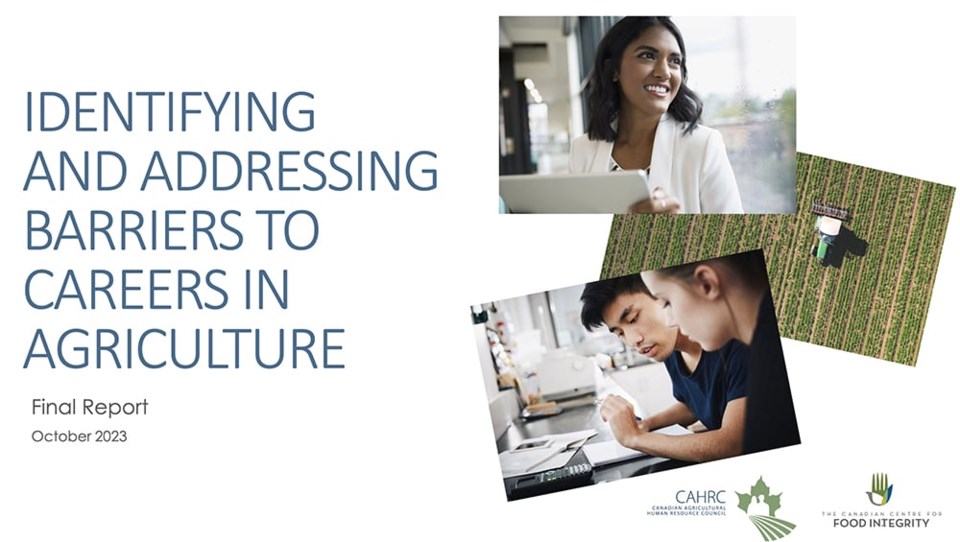WESTERN PRODUCER — There are plenty of job titles in agriculture, including agronomist, soil scientist, livestock truck driver, veterinarian, lab technician, swine technician, grain merchant, seed sales rep and of course, agricultural journalist.
There are dozens more job titles, probably hundreds.
However, a survey last year of more than 2,000 Canadians who are not connected to agriculture determined that very few people can name any of those jobs.
“A majority (54 percent) of Canadians are unable to identify a job in the agricultural industry that is not a farmer,” the Canadian Agricultural Human Resources Council said in .
Ipsos conducted the online survey in 2023, with respondents between the ages of 16 and 65 to reflect the population of Canada.
Jennifer Wright, executive director of CAHRC, hasn’t forgotten that finding from the survey.
It’s a reminder that agricultural leaders have “a lot of work to do.”
“Obviously, the job of a farmer is extremely important, but there are so many other occupations, jobs and career paths.… We need to be working to really be raising that awareness,” Wright said from her office in Ottawa in late February.
CAHRC has been trying to raise awareness about the labour shortages in Canadian agriculture and how to manage this crisis.
In mid-February, the council released a report called Sowing the Seeds of Change, an agriculture labour market forecast for 2023-30.
The report is 126 pages long and contains a massive amount of data, but the key messages are clear:
- More than 28,000 jobs went unfilled in the agriculture sector during the peak season in 2022.
- Those unfilled jobs caused lost sales of agricultural products worth an estimated $3.5 billion.
- By 2030 the domestic labour gap between Canadians willing to work in agriculture and the number of jobs available will grow to 100,000.
- That doesn’t mean 100,000 jobs will go unfilled, but temporary foreign workers and others will be desperately needed to fill them.
One of the key findings of the CAHRC report is that it’s getting harder to convince Canadians to work on farms. In many cases it’s impossible for farmers and companies in primary agriculture to hire Canadians because no one applies for the available jobs.
“More than one-third of employers (received) no applications from Canadians during this hiring season … while an additional 28 percent received only one or two applications,” says the Sowing the Seeds of Change report.
The data is from a CAHRC survey of farmers and primary agriculture employers in 2023 looking at their hiring challenges in 2022.
Alastair Bratton doesn’t need to look at such statistics.
He’s the production manager at Sunterra Farms, one of the largest hog producers in Alberta.
If Sunterra Farms posts four job advertisements, they might get one resumé from a Canadian.
“We just receive virtually zero applications, on any sort of basis, from Canadians,” he said.
“Even if we do, half the time … people are sort of doing it to say they’ve applied for a job.”
Sunterra is required to advertise for available positions as part of the process to hire a temporary foreign worker. The company, or anyone looking to hire a foreign worker, must demonstrate that locals are not available or interested in the work.
A large part of the problem is the rural location of hog barns and other agricultural jobs.
The rural population is shrinking and the population is different from urban areas. In a city, newcomers arrive all the time and those people need a job.
“The amount of resumés we receive and the amount of local interest we receive is so low…. If you pull from a population within 50 kilometres from your (farm) site, there isn’t new people coming to that area,” Bratton said. “Some farms are closer to bigger towns, but some aren’t.”
Returning to the issue of perception, it’s difficult to recruit a 25-year-old Canadian into an agricultural career if they can only name one job within agriculture.
“It’s not on people’s radar to look for (these) opportunities,” Wright said. “They may not understand how much automation and technology is in agriculture, how much science is in agriculture. They may not see themselves in those roles.”
Groups like CAHRC, Agriculture in the Classroom and Farm and Food Care are trying to change the outdated perceptions of agriculture, but it can be a hard slog, considering young Canadians get most of their information from TikTok and YouTube.
“The whole issue of food understanding and what farmers do … is becoming quite distorted through social media and always the negative side of things,” Bratton said.
Overcoming these obstacles — misperceptions, misinformation and the reluctance to live in rural communities — will require a huge effort from many players and agricultural leaders.
“Not one organization or one employer is going to be able to solve this problem alone,” Wright said.
“Everyone (has realized) we need to get on board and work together. Industry has taken the lead on that, and really looking at how we, as an industry, address some of these issues and insure we have that workforce we need, going forward.”




